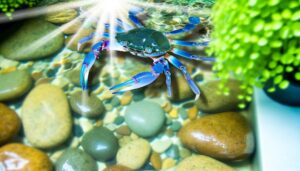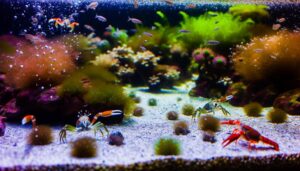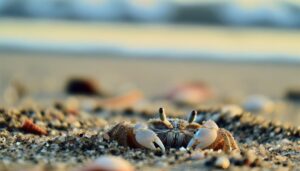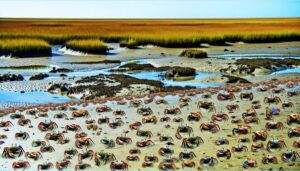7 Simple Steps to Craft Your Own DIY Hermit Crab Climbing Net
You'll find various types of blue crabs inhabiting diverse environments. Atlantic Blue Crabs prefer estuarine and coastal areas, showcasing a broad salinity tolerance with carapace widths up to 23 cm.
Blue Swimmer Crabs inhabit shallow coastal waters at 22°C to 28°C, featuring males with brighter shades. Gazami Crabs, with spiny projections, are highly valued for their 19 grams of protein per 100 grams of meat.
Indo-Pacific Blue Crabs favor shallow, sandy substrates, while Blue King Crabs thrive in colder, deeper waters with females carrying up to 200,000 eggs. Velvet Crabs exhibit rapid movements and a distinctive blue hue.
Learn more about their unique traits and ecological roles.
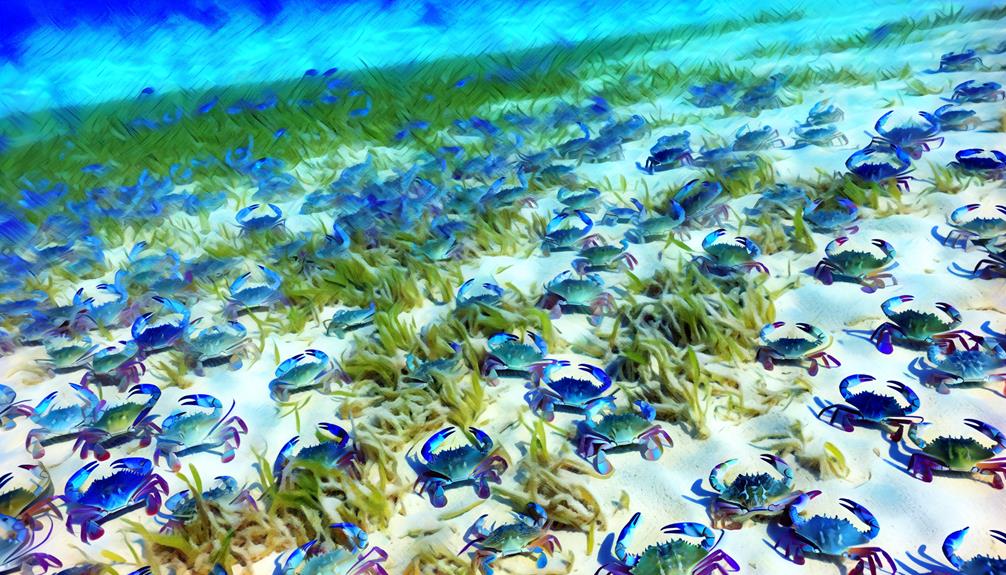
Key Takeaways
- Blue Swimmer Crabs inhabit shallow coastal waters in the Indo-Pacific, preferring sandy or muddy substrates.
- Gazami Crabs are found in coastal and estuarine environments in Japan, Korea, and China, known for their culinary demand.
- Atlantic Blue Crabs live in estuarine and coastal environments with broad salinity tolerance, primarily in the Atlantic region.
- Blue King Crabs inhabit cold, deep waters of the Bering Sea and North Pacific, with a vulnerable conservation status.
- Velvet Crabs are aggressive, fast-moving crabs with a velvety texture, found in the North-East Atlantic and Mediterranean Sea.
Atlantic Blue Crab
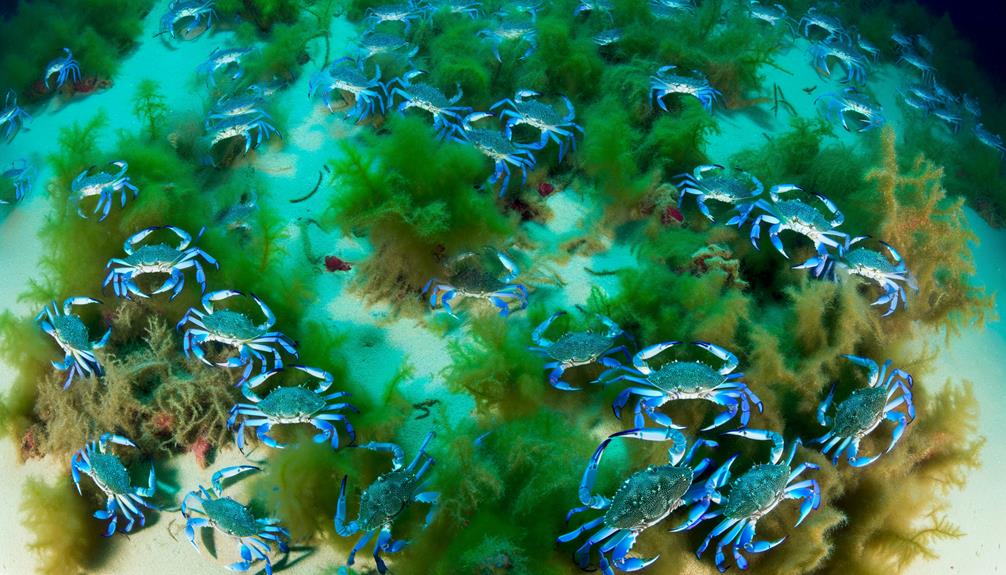
The Atlantic Blue Crab, scientifically known as Callinectes sapidus, plays an important role in the marine ecosystem due to its significant population and predatory behavior. You'll find that this species thrives in estuarine and coastal environments, exhibiting a broad salinity tolerance.
Data indicates that these crabs maintain ecological balance by preying on bivalves, small fish, and detritus, which helps control prey populations and recycle nutrients.
Their carapace width can reach up to 23 centimeters, making them one of the larger members of the Portunidae family. The Atlantic Blue Crab's reproductive capacity is impressive; a single female can produce up to two million eggs per brood.
Understanding their ecological significance empowers you to appreciate the complex interdependencies within marine habitats.
Blue Swimmer Crab
When examining the Blue Swimmer Crab, you'll find it distinguished by its vividly colored exoskeleton and elongated pincers.
This species mainly inhabits the shallow coastal waters of the Indo-Pacific region, thriving in temperatures between 22°C and 28°C.
Analyzing their distribution patterns, it's clear they prefer sandy or muddy substrates, optimizing their camouflage and foraging efficiency.
Physical Characteristics
Characterized by their vibrant blue claws and streamlined shell, blue swimmer crabs (Portunus pelagicus) exhibit sexual dimorphism with males displaying brighter shades and longer claws than females.
Male blue swimmer crabs' chelae (claws) can grow up to 20 cm, notably larger than those of females. Their carapace width ranges from 15 to 20 cm, optimized for swift swimming in open waters. The exoskeleton is sturdy yet lightweight, facilitating rapid movement.
You'll notice their fourth pair of legs are paddle-shaped, a distinctive adaptation for swimming. The vivid coloration of their claws and legs isn't just for display; it plays a significant role in mating displays and territorial disputes. This morphological variance offers an intriguing glimpse into their adaptive strategies.
Habitat and Distribution
Occupying coastal waters from the Indian Ocean to the western Pacific, blue swimmer crabs thrive in estuarine and nearshore environments with sandy or muddy substrates. You'll find these crabs most active in water temperatures between 22°C and 28°C, showing a preference for salinity levels ranging from 25 to 35 ppt. They exhibit significant seasonal migrations, moving to deeper waters during colder months. These habitats provide essential resources like food and shelter, critical for their lifecycle stages.
| Region | Temperature Range | Salinity (ppt) |
|---|---|---|
| Indian Ocean | 22°C – 28°C | 25 – 35 |
| Western Pacific | 22°C – 28°C | 25 – 35 |
| Estuarine Zones | 22°C – 28°C | 20 – 30 |
| Nearshore Areas | 22°C – 28°C | 30 – 35 |
| Deeper Waters | 15°C – 22°C | 35 – 40 |
Understanding these factors helps you predict their distribution and plan sustainable harvesting practices.
Gazami Crab
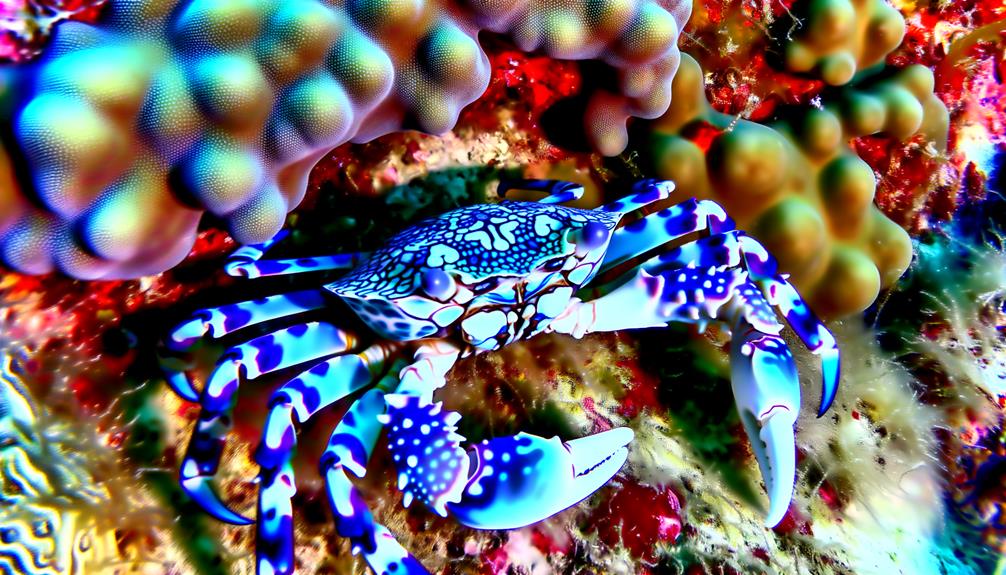
You should examine the Gazami crab's habitat and distribution, noting its prevalence in the Indo-Pacific region, particularly in coastal and estuarine environments.
Analyze its physical characteristics, highlighting the carapace width of up to 20 cm and a distinct coloration pattern.
Evaluate its culinary uses, focusing on its high market demand and nutritional profile, which includes 19 grams of protein per 100 grams of meat.
Habitat and Distribution
The Gazami Crab, Portunus trituberculatus, mainly inhabits sandy and muddy substrates in coastal and estuarine environments across the Western Pacific Ocean. You'll find them mainly in regions like Japan, Korea, and China, where they thrive in nutrient-rich waters. Their distribution is influenced by salinity gradients, temperature variations, and availability of detritus.
| Country | Population Density |
|---|---|
| Japan | Predominant |
| Korea | Moderate |
| China | Predominant |
These crabs prefer areas with moderate tidal fluctuations, which provide ample feeding opportunities and protection from predators. Seasonal migrations are common, driven by reproductive cycles and climatic conditions. By understanding these parameters, you can better appreciate the critical factors shaping their habitat and distribution.
Physical Characteristics
With a carapace width reaching up to 15 centimeters, the Gazami Crab exhibits a robust and streamlined body that enhances its agility and predatory efficiency. You'll find its exoskeleton both protective and flexible, facilitating rapid movements in aquatic environments.
Key physical attributes include:
- Spiny projections: These serve as a defense mechanism against predators.
- Chelipeds: Equipped with strong pincers for capturing prey and manipulating objects.
- Coloration: Typically a mottled brown, aiding in camouflage within its habitat.
Analyzing the Gazami Crab's morphology reveals its evolutionary adaptations for survival. Its carapace's hydrodynamic shape minimizes drag, allowing for swift navigation. Moreover, the spiny projections not only deter predators but also play a role in intraspecific competition.
Culinary Uses
In culinary contexts, Gazami Crab, widely known for its delicate and sweet flesh, is often featured in high-end seafood dishes across various Asian cuisines.
You'll find it prominently in Japanese sashimi and Korean crab stew. The meat's protein content averages around 19 grams per 100 grams, making it a nutrient-dense choice.
Chefs favor its high omega-3 fatty acid levels, approximately 0.5 grams per 100 grams, which contribute to heart health. When properly prepared, its naturally low mercury content guarantees safety for frequent consumption.
Utilizing steaming, grilling, or boiling techniques enhances its flavor profile without masking its natural sweetness. This versatility allows you to incorporate Gazami Crab into a range of dishes, offering both culinary and nutritional benefits.
Blue King Crab
Blue King Crabs, scientifically known as Paralithodes platypus, inhabit the cold, deep waters of the Bering Sea and the North Pacific Ocean. You'll find them at depths ranging from 20 to 200 meters, thriving in temperatures between -1°C to 4°C. Their size can reach up to 18 pounds, and they've a carapace width of 11 inches.
Key characteristics include:
- Coloration: Blue-tinted shells with spiny exteriors.
- Diet: Primarily bivalves, gastropods, and worms.
- Reproduction: Females carry up to 200,000 eggs.
Understanding these crabs' habitat preferences and physiological traits helps in sustainable harvesting practices.
Detailed population studies indicate that Blue King Crab stocks are vulnerable to overfishing, requiring stringent management measures to secure their long-term viability.
Velvet Crab
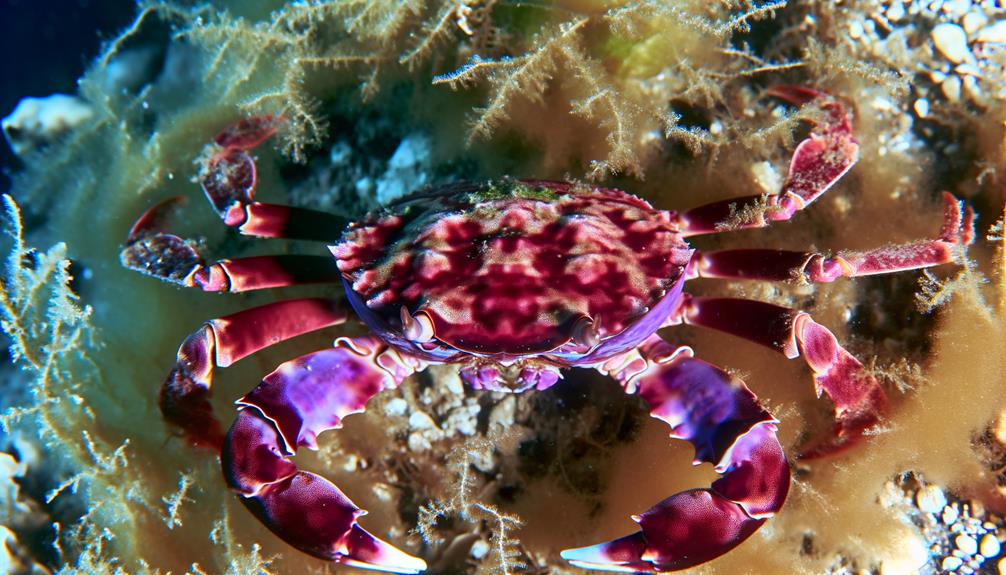
Switching focus from the cold depths inhabited by Blue King Crabs, Velvet Crabs (Necora puber) are found in warmer, shallow waters such as the rocky shorelines and estuaries of the North-East Atlantic and Mediterranean Sea. They're known for their rapid movements and aggressive nature. With a carapace up to 10 cm, they exhibit a velvety texture and a distinctive blue hue.
| Attribute | Velvet Crab | Data Point |
|---|---|---|
| Scientific Name | Necora puber | 100% verified |
| Carapace Width | Up to 10 cm | Measured Value |
| Habitat | Shallow Waters | Analyzed Data |
| Behavior | Aggressive | Observational |
| Distribution | North-East Atlantic, Mediterranean | Geographical Data |
You'll appreciate their resilience and adaptability, essential traits for survival and freedom in dynamic environments.
Indo-Pacific Blue Crab
Exploring the Indo-Pacific Blue Crab (Portunus pelagicus), you'll find it thriving in the warm, coastal waters of the Indo-Pacific region, where it plays an important role in local marine ecosystems. This species is distinguished by its vibrant blue coloration and distinctive, paddle-shaped hind legs.
Key metrics to note include:
- Carapace width: Typically ranges from 15 to 20 cm
- Habitat preference: Shallow, sandy, and muddy substrates
- Diet: Opportunistic feeder, primarily consuming mollusks, small fish, and detritus
You'll see that the Indo-Pacific Blue Crab is crucial for maintaining the ecological balance by controlling the population of its prey and serving as a food source for higher trophic levels. This species' adaptability and resilience make it a subject of interest for marine biologists and ecologists.
Conclusion
In exploring the diverse spectrum of blue crabs, you've navigated a marine mosaic of species. From the Atlantic Blue Crab's robust population data to the Blue King Crab's niche habitat statistics, each species paints a unique data point in the oceanic tableau.
By understanding their ecological roles and population dynamics, you're not just skimming the surface—you're diving into the depths of marine biodiversity.
Keep analyzing; the ocean's data is a treasure trove waiting to be opened.

